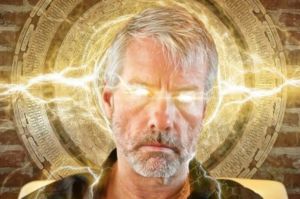Michael Saylor

Michael Saylor: The God of Bitcoin or Its Anti-Hero?
Michael Saylor, the enigmatic co-founder and executive chairman of MicroStrategy, is arguably one of Bitcoin’s most polarizing figures. To some, he is a visionary hero—Bitcoin’s “digital messiah,” evangelizing the benefits of decentralized money to a skeptical world. To others, he is an anti-hero, a larger-than-life figure whose actions and philosophy toe the line between benevolence and hubris.
His latest revelation is perhaps his most controversial yet: upon his passing, Saylor plans to destroy the private keys to his Bitcoin holdings, effectively taking his vast cryptocurrency fortune out of circulation forever. On the surface, this act may appear altruistic—a grand gesture to increase the scarcity of Bitcoin and, in turn, its value for the global Bitcoin community. But is it really a gift to the world, or is it the ultimate flex of an anti-hero in the crypto saga?
The Plan: Destroying the Keys, Securing the Scarcity
To understand the magnitude of Saylor’s intentions, you first need to understand how Bitcoin works. Bitcoin ownership is secured through private keys, which are cryptographic strings that act as passwords to access funds. Lose the keys, and your Bitcoin is as good as gone, inaccessible for eternity.
By destroying his private keys, Saylor aims to remove his Bitcoin from circulation permanently. Given Bitcoin’s capped supply of 21 million coins, any reduction in the circulating supply makes the remaining Bitcoin more valuable. For a community that thrives on scarcity as a fundamental principle, Saylor’s act is ostensibly a boon. But beneath the surface, this plan raises profound questions about Saylor’s role in the Bitcoin ecosystem and his motives.
The Anti-Hero Narrative
Saylor’s plan, while framed as a selfless contribution to the Bitcoin community, has anti-hero undertones. His decision to “burn” his Bitcoin upon his death ensures that no one else can benefit from the vast fortune he has accumulated. Some might argue this is an act of poetic justice—denying greedy heirs or opportunistic governments a chance to cash in on his wealth. Others might see it as an egotistical power play, a move that cements Saylor’s legacy as Bitcoin’s ultimate maverick.
Here’s the twist: while the destruction of private keys may make the remaining Bitcoin more valuable, it also underscores the inherent fragility of Bitcoin as an asset. In a system that depends on human stewardship of cryptographic keys, Saylor’s plan reveals the Achilles’ heel of decentralization. By taking his Bitcoin to the grave, he not only diminishes the circulating supply but also reminds us of the irreversible finality of lost Bitcoin—a sobering reality in a system that markets itself as immutable and eternal.
A Hero with Flaws
To some, Michael Saylor is the face of Bitcoin’s ascension. His company, MicroStrategy, became the first publicly traded firm to adopt Bitcoin as its primary reserve asset, setting off a wave of institutional interest in cryptocurrency. He championed Bitcoin during its darkest days, standing firm against critics and governments alike. But even heroes are not without flaws.
Saylor’s single-minded focus on Bitcoin as “digital gold” has often sidelined the broader principles of decentralization and financial inclusion that underpin the cryptocurrency revolution. His public persona—grandiose, unwavering, and unyielding—has drawn criticism for being cult-like, a far cry from the grassroots ethos that birthed Bitcoin.
Saylor’s Legacy: Savior or Saboteur?
Saylor’s plan to destroy his Bitcoin private keys is the perfect encapsulation of his duality. On one hand, it reinforces the scarcity narrative that Bitcoin thrives on, potentially benefiting the entire community. On the other hand, it highlights the contradictions in the Bitcoin ethos: a decentralized system reliant on individual actors with near-godlike control over their wealth.
In the end, Michael Saylor may not be Bitcoin’s savior, nor its saboteur. He exists in the murky gray space between hero and anti-hero, a figure who both propels Bitcoin forward and exposes its vulnerabilities. His plan to take his Bitcoin keys to the grave is not just a personal decision—it’s a statement, a reflection of Bitcoin’s promise and its pitfalls.
Perhaps that’s what makes Saylor so fascinating. In a space filled with grifters, dreamers, and revolutionaries, he is something else entirely: a man who sees himself as a steward of Bitcoin’s future, even if it means rewriting its rules on his own terms. Whether history remembers him as the god of Bitcoin or its anti-hero remains to be seen, but one thing is certain—Michael Saylor’s story is far from over...